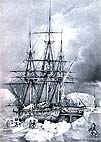
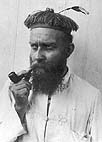
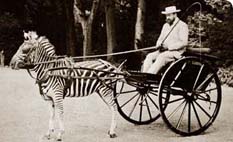
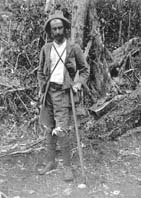

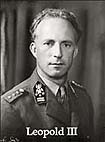








Papua-Insects.nl
The Papua Insects Foundation
History of expeditions in Papua Indonesia
When speaking of "Papua", the western part of the island is meant in all political periods (Dutch New Guinea, West Irian, Irian Jaya and Papua Indonesia).
A great number of expeditions have been made in the interior of Papua, but not all were biological surveys. We restrict ourselves here in listing only the biological expeditions, during which presumably or certainly Lepidoptera and other insects were collected in Papua and to major events for Papua.
Archaeological history
The first inhabitants of New Guinea, black skinned and frizzy haired, first arrived from the west perhaps 60,000 years ago. While the sea level was considerably lower at the time of man's first migrations to Australia and New Guinea, there were still stretches of ocean to cross. Rising seas eventually cut off Australia from New Guinea and led to the divergent gene pools which now show up in the somewhat different physical types. Small groups settled along the seashores and short distances inland, living from hunting, fishing and gathering. There must have been but slight contact between these groups on what was to merge as the island of New Guinea. In recent studies, linguists were amazed to learn that on this island, with only 0.01 % of the earth's population, 15 % of the world's languages are spoken. Out of an almost incredible 800 languages (not dialects), about 550 are found in Papua New Guinea and some 250 in Irian Jaya (Papua).
By 4000 B.C., agriculture was well developed, leading to some population concentration and stable social structure. Then the next waves of immigration began washing up on the shores of Papua. The newcomers, who originated from South China and dispersed from Taiwan, slowly spread over a time span of two millennia to populate the Philippines, Indonesia, Malaysia, Micronesia and Polynesia. In most areas, this new breed, called Austronesian, replaced existing populations thanks to their more advanced technology in tools, weapons and agricultural skills. But in New Guinea, the majority of the long-established Papuans successfully resisted assimilation by the Austronesians who established themselves only on some nearby islands and coastal strips.
The next great step in Papua's history was the "sweet potato revolution". Plant geneticists still have not established an accurate date for the introduction of the sweet potato to New Guinea, but the impact of this new tuber revolutionised the population distribution and resulted in large increases. The sweet potato, unlike taro and other previously planted crops, grows well above the 1,500 meter line of altitude. This crucial fact placed its cultivation beyond the normal range of the malarial mosquito which had - up to then - kept down the number of humans. The intensive agricultural technique of planting the sweet potato resulted in great yields which also helped to increase the population in the highlands of New Guinea.(from: www.janesoceania.com)
Major events and early expeditions
- 1511 - New Guinea is discovered by the Portuguese Antonio d'Abreu and Francisco Serrano.
- 1526 - The first foreigner, the Portuguese governor of Ternate Jorge de Menezes, sets foot on New Guinea at Warsai (Birdshead Peninsula) on what he calls "Ilhas dos Papuas".
- 1545 - The Spanish Ynigo Ortiz de Retes named New Guinea for the first time "Nueva Guinea" (meaning "New land of wealth", Parsons, 1999). He lands somewhat east of the Mamberamo River.
- 1623 - Jan Carstensz sails south of New Guinea and spotted the snow covered mountains for the first time, which is at first disbelieved in Europe.
- 1678 - At July 31 1678 Johannes Keyts was the first to plant the Dutch flag on New Guinea, at the westpoint of Onin Peninsula (northwest of Fakfak).
- 1705 - The Dutch explorer Jacob Weyland discovers the Geelvink Bay (Cenderawasih Bay). The mountain range in the south of this bay is later named after him.
- 1768 - The explorer Louis-Antoine de Bougainville names the Cyclops Mountains in the northeast of Papua.
- 1793 - The first attempt to colonize New Guinea was made by the British Lieutenant John Hayes, who settled a small village “New Albion” with Fort Coronation at Dorey Bay (now Manokwari). In April 1795 New Albion was abandoned because of constant hostile attacks of the natives.
- 1826 - Dumont D'Urville visits the Dorey Bay (where at present Manokwari is settled) and meets for the first time Arfak people. He is passenger on the ship D'Astrolabe of L.J. Duperrey. Later he visited Offack (on Waigeo). All kind of animals and plants were collected.
- 1828 - The Dutch claim the western part of New Guinea. Their first settlement is at Fort du Bus in the Triton Bay. In 1836 the fort is abandoned.
- 1828 - Salomon Müller collects butterflies in Lobo, Triton Bay.
- 1838 - The second visit of Dumont D'Urville, now in Triton Bay.
- 1848 - The border of Dutch New Guinea is laid down at 141º Eastern Length by the government of the Dutch Indies. It was officially determined in 1895 and is until present day the unchanged border of Papua with Papua New Guinea.
- 1855 - The first missionaries arrive in Papua. The Germans C.W. Ottow and J.G. Geissler settle on Mansinam, the island in the Dorey Bay (near Manokwari).
- 1858 - The "Etna Expedition" explores the Argoeni and Lakahia Bay in search for pit-coal. Resident H.D.A. van der Goes examines the country and people. He also explores the surroundings of the Humboldt Bay and discovers the Sentani Lake of which he believed it to be another bay of the sea. He held a small expedition in the Arfak Mountains.
- 1858 - Alfred Russel Wallace spends a few weeks at Doré (now Manokwari), collecting birds and insects. His collectors go in the Arfak Mountains. He also collected at the North coast of the Birdshead Peninsula, Waigeo and Salawati.
- 1861 - Ch. Allan, assistent of Alfred Russel Wallace, enters the Birdshead Peninsula at Sorong and spends a month in the mountains. He also visited Mysol (Misool).
- 1872 - The Italian naturalist Luigi Maria D'Albertis makes a trip from Andai to Mt. Hattam (Arfak).
- 1873 - The German Adolf Bernhard Meyer, from the Zoology Museum in Dresden, visited Dorey Bay and collected lepidoptera. He also visited Manem (now Manim, a small island West from Numfor), Mafoor (now Numfor), Mysore (now Biak and Supiori) and Jobi (now Japen or Yapen). He explored the whole "Geelvink" (Cenderawasih) coast. Click to go to the map of his route.
- 1875 - The Italian naturalist O. Beccari visits Sorong and discovers Wai Samson and the mountains Morait and Aas at West Birdshead Peninsula. He climbs in the Arfak Mountains and reaches Mt. Hattam (2040 m).
- 1877 - The French naturalist L. Laglaize visits the Karoner, Amberbaker and Kebar people at the Northcoast of the Birdshead Peninsula.
- 1883 - 1884 The French naturalist F.H.H. Guillemard visits Waigeo, Batanta, Mysol (Misool), Jobi (Yapen) and the Birdshead Peninsula. He collected birds, butterflies and other insects.
- 1889 - For 9 years the German collector H. Kühn collected in New Guinea and the adjacent islands. He collected also on the Kay Islands and on Mysol (Misool).
- 1891 - The Swiss Hans Fruhstorfer visits the Birdshead Peninsula and collected many Lepidoptera. His material is still preserved in the BMNH and ZMHB.
- 1892 - The English animal collector W. Doherty discovers that the Sentani Lake in fact is a lake and he explores the area around the Humboldt Bay and collected many birds and insects, of which mostly butterflies. He also visited the Geelvink Bay (Cenderawasih Bay) (Wendesi, Andai and Dorey), and the islands Jobi (Yapen) and Roon.
- 1894 - The British sea captain H.C. Webster collected butterflies and birds in the Etna Bay.
- 1896 - W. Doherty visits New Guinea for the second time, now visiting Kapaur (now Fakfak), Jobi (Yapen), Biak, Mafor (Numfor), Dorey Bay and Roon.
- 1896 - Zoologist E.St. Vraz explores the Arfak Mountains and reaches up to 20 km South of Mt. Hattam.
- 1898 - Manokwari and Fakfak are founded.
- 1903 - Scientific expedition of Sentani Lake and surrounding area by A. Wichmann, G.A.J. van der Sande, L.F. de Beaufort, H.A. Lorentz and J.M. Dumas of the Treub Company and the Royal Dutch Geographical Society (K.N.A.G.).
- 1904 - 1905 "The first Southwest New Guinea expedition" (K.N.A.G.) on the Digoel River, the Setakwa River and the Etna Bay, by J.A. Kroesen, R.J. Posthumus Meyjes, E.J. de Rochemont, J.W.R. Koch and C. Moerman.
- 1904 - L.A. van Oosterzee discovers the Angi Lakes in the Arfak and Capt. J.H. Hondius van Herwerden discovers Mt. Wilhelmina (now Mt. Trikora).
- 1905 - "The second Southwest New Guinea expedition" (K.N.A.G.) on the Digoel River by J.A. Kroesen and R.J. Posthumus Meyjes.
- 1905 - A.E. Pratt visits Fakfak from May to June to collect Lepidoptera.
- 1907 - "The first South New Guinea expedition" by H.A. Lorentz, J.W. van Nouhuys, G.M. Versteeg and J.M. Dumas. Discovery of mountain Papuans, "Pesegems".
- 1907 - A.E. Pratt visits Fakfak again from December 1907 to February 1908. He also visited, together with his two sons Felix and Charles Pratt, the Arfak Mountains near Manokwari. Charles also visited Wendesi (December 1908) and Warmasin (Anggi Lakes, Arfak Mountains, February 1909). Both brothers, Felix and Charles, together visited Mioswaar (October 1909) and went on the River Uty and Mt. Misresi in the Arfak Mountains. At the end of their trip they spent months in the Cyclops Mountains at the Humboldt Bay. Pratt senior and his two sons collected for six months on Biak Island.
- 1909 - During a exploration of the Digoel River Mt. Juliana is discovered (now Mt. Mandala).
- 1909 - 1910 "The second South New Guinea expedition" by H.A. Lorentz, J.W. van Nouhuys, L.I.A.M. von Römer, R. Jaarman and D. Habbema. They reach the snow of Mt. Wilhelmina (Mt. Trikora).
- 1909 - 1911 "The first English South New Guinea expedition" by W. Goodfellow, A.F.R. Wollaston, G.R. Shortridge, W. Stalker, Capt. C.G. Rawling, E.S. Marshall and N.I.L.H.A. Cramer (by the British Ornithological Union). They came in touch with small mountain Papuans.
- 1910 - Capt. Schaeffer reaches Mt. Goliath (Mt. Yamin) (in 1911 he reaches at 3340 m).
- 1910 - Lieutenant Van der Bie, Postema and Dumas explore the Setakwa and Utakwa River. The famous naturalist A.S. Meek was accompanying them as a guest and collected many Lepidoptera until March 1911.
- 1912 - 1913 - "The third South New Guinea expedition" by Capt. A. Franssen Herderschee, A.A. Pulle, P.P. Hubrecht, G.M. Versteeg, J.H. Sitanala and Lieutenant L.A. Snell. They reach the top of Mt. Wilhelmina (Mt. Trikora).
- 1912 - 1913 "The second English South New Guinea expedition" by Wollaston, C. Bowden Kloss, Capt. Rawling and Lieutenant A. van de Water, also known as the "Wollaston Expedition". They do not succeed in reaching the snow of Mt. Carstensz (Mt. Jaya) for 400 meters! Wollaston collects many Lepidoptera of great importance on this expedition.
- 1913 - A.E. Pratt and his two sons Felix and Charles plan a new trip to the Anggi Lakes in the Arfak Mountains.
- 1913 - J.C. Baggelaar collected many Lepidoptera from the western part of Papua, from McCluer Gulf (Berau Bay) to Arguni Bay.
- 1914 - In order of J.J. Joicey (owner of the private Hill Museum) A.E. Pratt and his sons collected in the Arfak Mountains and on the Schouten Islands (i.e. Biak and Supiori). At the end of 1914 they went to the Wandammen Mountains. In February to April 1915 the Pratts collected on Waigeo.
- 1916 - W.J.C. Frost collected butterflies on Mysol (Misool).
- 1920 - Charles, Felix and J. Pratt visit the Weyland Mountains and the Menoo River and Mt. Kunupi. They also collected on Mefor (Numfor).
- 1920 - 1921 "The Central New Guinea Expedition", a scientific expedition to the Nassau Mountains and Mt. Wilhelmina along the Mamberamo by A.J.A. van Overeem, J.H.G. Kremer, J. van Arkel, K. Drost, J. Kooij, H.J.T. Bijlmer, A. ten Haaf, H. de Rook, J. Jongejans, P.F. Hubrecht, W.C. van Heurn, H.J. Lam and P. Droog (Indian Committee for Scientific Surveys).
- 1926-1927- The Dutch-American expedition to the Nassau Mountains, also called "the Stirling Expedition", led by dr. Matthew W. Stirling and with the members W.M. Docters van Leeuwen, C.C.F.M. le Roux, S. Hedberg, R. Peck, J. Hoyte, H. Hamer, Capt. R.W. Posthumus, H. Hoffman, J. Jordans and J.H. Korteman (Indian Committee for Scientific Surveys).
- 1928 - Ernst Mayr, a German ornithologist, collected birds, mammals, plants and insects on the Birdshead Peninsula, mostly from the Arfak Mountains. Later he collected in the Wandammen Mountains and the Cyclop Mountains.
- 1928 - F.S. Meyer started with his New Guinea visits in 1928 for 40 years onwards. In 1928 he visited the Birdshead Peninsula.
- 1928-1929 - From December 1928 till May 1929 Prince Leopold from Belgium visits the Dutch Indian Archipelago. He also visited Misool, the southwest coast of New Guinea (Triton Bay), Japen and the Arfak Mountains. Apart from other animals he collected also insects ((type)material in ISNB, Brussels).
- 1930 - F.S. Meyer visits the Weyland Mountains.
- 1932 - Miss Lucy E. Cheesman visits the Cyclops Mountains to collect insects. She was the first female explorer in the area and it is especially remarkable because she travelled alone, in a time that it was not really save even for men.
- 1933 -1934 "The First Archbold Expedition" in New Guinea, by the wealthy American Richard Archbold.
- 1934 - W. Stüber collected flora and fauna for sale from the Humboldt Bay region and the backland of Hollandia (Jayapura) in May 1934. Butterflies, moths and other insects where sold to BMNH, RMNH and to Dr. J.M.A. van Groenendael, who donated his large collection of Indonesian Lepidoptera (and some other insects) to the ZMAN.
- 1936 - "The Colijn Expedition" to the Carstensz Peak (Mt. Jaya), lead by A.H. Colijn, F.J. Wissel and J.J. Dozy. Hardly any insects were collected, since it was a more geological expedition. During this expedition two important discoveries were made: the Wissel Lakes and, coincidentally, the Baliem Valley.
- 1936 - Miss L.E. Cheesman joins "the Second Archbold Expedition" in the Cyclop Mountains.
- 1938 - Miss L.E. Cheesman visits Waigeo and Yapen to collect insects.
- 1938 - 1939 Miss L.E. Cheesman joins "the Third Archbold Expedition" to the Snow Mountains, which was very successful. L.J. Toxopeus leads the expedition and the following. In this expedition also the Wissel Lakes (Paniai) and the Baliem Valley were visited.
- 1939 - "The fourth and last of the pre-war Archbold Expeditions" (another four were held after Worldwar II but much less ambitious), or the Central New Guinea Expedition 1939 by the Royal Dutch Geographical Society, or the Le Roux Expedition, to the Nassau Range (surroundings of Lake Habbema and Mt. Wilhelmina), the Central Mountain Range and the surroundings of Hollandia (Jayapura).
- 1939 - R.G. Wind and his wife visited Fakfak and Merauke to collect butterflies and insects, which were sold to museums.
- 1941 - "The Negumy Expedition" in the southern Birdshead Peninsula, which was joined by E. Lundquist who collected butterflies.
- 1942 - Occupation of New Guinea by the Japanese.
- 1959 - "Expedition to the Star Mountains" with L.D. Brongersma and G.F. Venema. Lepidoptera are collected in Mabilabol (Oksibil). Collected material is mainly stored in the collection of RMNH, some in BMNH and ZMAN.
- 1963 - At the 1st of May Dutch New Guinea is handed over to the Indonesian government and is named West Irian. In 1973 the province is named Irian Jaya. In 2000 it became Papua, which was divided becoming two provinces: the western (including the Birdshead) was named Irian Jaya Barat and since April 2007 Papua Barat, the eastern province is named Papua.
Expedition in the Star Mountains, 1959. (from: "Het witte hart van Nieuw-Guinea" [The white heart of New Guinea], Brongersma & Venema, 1960)
Modern expeditions
Because traveling to and in New Guinea is no longer exclusive for the very fortunate and rich explorers anymore, since cruises and airlines are frequently visiting the larger cities, it has become impossible to keep up a complete list of modern expeditions and visits from entomologists. Tourists and collectors will have taken the opportunity to collect butterflies and other insects for their collections. However, modern scientific inventories are not much undertaken yet in Papua.
From the late 1970's the missionary Henk van Mastrigt has been (and still is) active with collecting in the area. His enormous collection is in Jayapura and comprises all families of Lepidoptera with species from mostly the northeastern part of Papua (Mamberamo, Jayapura, Baliem Valley, Star Mountains, etc.). His specialization in the genus Delias (Pieridae) has lead to many scientific publications with many new (sub)species. Through his enthusiastic and experienced guidance it was possible to held five recent expeditions with scientists from The Netherlands.
In 1993 an expedition was undertaken for 8 weeks to the Baliem Valley, the Birdshead Peninsula, Wandammen Peninsula, Roon and Biak (R. de Vos, A.J. de Boer and A.L.M. Rutten).
In 1996 it was followed by an expedition for 9 weeks to the Birdshead Peninsula, Batanta and Wandammen Peninsula (R. de Vos, A.J. de Boer, P.J. Zumkehr, G. Withaar and H. de Jong).
Since 2000 students of the Cenderawasih University have been involved in a series of entomological surveys, cooperating with Conservation International Indonesia and/or Henk van Mastrigt, as follows:
· Around Yongsu at the Cyclops Mountains (2000)
· The Mamberamo area around Dabra (2000)
· The isles of District Pantai Timur: Wakde, Yamna, Masih-masih, Podena, Yarson and Anus (2001).
· The Kumamba islands, north of Sarmi (2002).
· The Moor and Mambor islands, norths of Nabire (2003).
· The south side of the island Supiori (2004).
· Mamberamo area in the environment of Marina Vallen (2004)
· The environment of Fak-Fak (2004)
· The island Numfor (2005)In 2005 an expedition was held together with students and teachers of the University of Cenderawasih (UNCEN) in Waena (near Jayapura) for 7 weeks to the Star Mountains and Walmak (District Nipsan) in the Jayawijaya Mountains (R. de Vos, G. Withaar, P.J. Zumkehr, J.H.H. Zwier, T. Lackner and D. Mannering). During these expeditions many insects have been collected and are now stored in the Zoological Museum of Amsterdam (ZMAN) and awaits scientific research (some of it is already in research).
In October 2008 two surveys were held by members of the Papua Insects Foundation (R. de Vos, P.J. Zumkehr, V. Kalkman, J. de Vos and J. Schaffers) and students of UNCEN at the north coast of Supiori Island and again in Walmak. Two members visited also Lelambo, a small mountain village at an altitude of 900 meters, somewhat north of Walmak. The insect material which has been collected is stored in the Zoological Museum of Amsterdam (ZMAN). During this survey many macro-photographs of insects were made by J. Schaffers which will be used for this website.
In October-November 2011 a fifth survey was held by the Papua Insects Foundation (R. de Vos, P.J. Zumkehr, G. Withaar, J. Schaffers (partly), H. Smit, J. & S. Sinnema and S. Lamberts). This time mainly the Birdshead Peninsula was visited: The Arfak Mountains (Mokwam, Anggi Lakes) and Senopi (Tamrau Plateau).
In November 2014 Piet Zumkehr, Siep and Janny Sinnema and Frans Groenen visited Fakfak (Onin Peninsula) and Mokwam (Arfak Mts.). In October 2015 Rob de Vos, Daawia Suhartawan and Erlani Rahareng had the same plan but this was frustrated by many forest fires which resulted in closing most of the airfields in the South. Instead they visited Kaimana and the primary forest of the Buruway District, near the Kumawa Mountains.
In November-December 2005 the Foja Mountains Expedition was held by LIPI and Conservation International. It was undertaken for four weeks and its results were amazing. Lots of new animals an plants were discovered in an area where probably almost no people have been before. About 25 specialists joined this expedition (supervised by Bruce Beehler), among which our contributor Henk van Mastrigt and Evie L. Warikar (UNCEN), who collected all kind of insects, of which many appeared to be new to science.
At the end of October till November 2008 another Foja Mountain Expedition by the same organisors was held and again our contributor and butterfly specialist Henk van Mastrigt was participating. There was again a lot of rain this time but Henk managed to collect more butterflies than before and also the moths were quite abundant. Results of this expedition will follow later in this website.
In March 2009 a survey was held on Misool Island by the Entomological Society of Latvia (Lettland) with D.Telnov, M.Kalnins, K.Greke and Z.Pipkaleja. They studied insects and non-marine Mollusca. In 2010 members of the same society visited the Birdshead Peninsula (West Papua) in "the neck" (Kaimana, Triton bay, Bitsyari bay, Triton lakes) and Onin Peninsula (Fakfak Mountains). In autumn of 2015, Dmitry Telnov visited Ayamaru / Aitinyo area on Doberai peninsula, the Arfak Mountains and the Anggi lakes, as well as Merauke & Transfly region.
updated on 8th December 2015